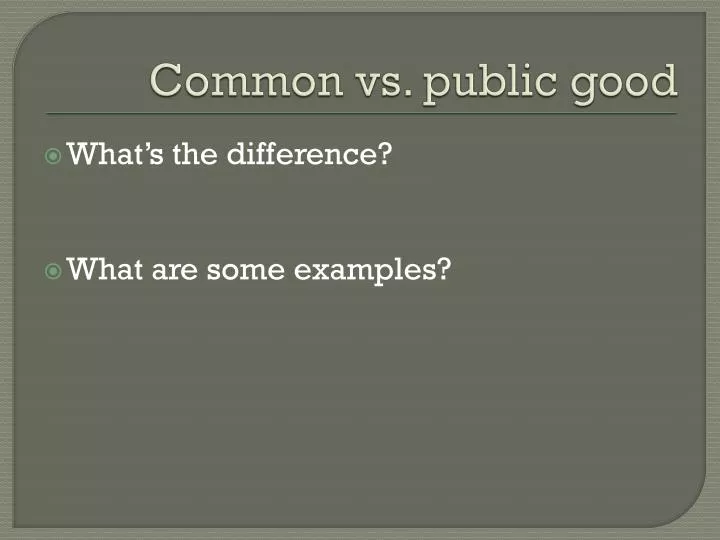Public Good Vs Common Resource

The distinction between a public good and a common resource is pivotal in understanding economic theory and the management of resources. While both concepts deal with resources that are shared among individuals or groups, the key characteristics and implications of public goods and common resources differ significantly.
To begin with, a public good is a product or service that is non-excludable and non-rivalrous. Non-excludability means that it is impossible or extremely costly to exclude anyone from using the good or service, regardless of whether they have paid for it. Non-rivalry implies that the consumption of the good by one person does not reduce its availability to others. Classic examples of public goods include national defense, street lighting, and environmental protection. These goods are typically provided by the government or through collective action because their public nature makes it difficult for private markets to produce them efficiently.
On the other hand, a common resource, often referred to as a common-pool resource, is a type of good that is shared among multiple individuals or groups but is rivalrous, meaning its use by one person reduces its availability to others. However, common resources are also characterized by non-excludability, similar to public goods. The quintessential example of a common resource is a fishery. While it’s challenging to exclude boats from fishing in open seas, the catch by one boat reduces the fish available for others, illustrating the rivalry in consumption. Other examples include groundwater basins, grazing lands, and the atmosphere.
The management of common resources poses significant challenges due to the risk of overuse, often referred to as the “tragedy of the commons.” This concept, introduced by Garrett Hardin, describes how multiple individuals acting in their own self-interest can lead to the depletion of a shared resource, even when it is clear that this is not in anyone’s long-term interest. The tragedy of the commons highlights the need for cooperative management strategies or regulatory frameworks to ensure the sustainable use of common resources.
In contrast, the provision of public goods faces challenges related to free-riding, where individuals benefit from the good without contributing to its costs, assuming others will bear the expenses. This can lead to underprovision of public goods, as individuals may not have an incentive to contribute voluntarily. Governments often step in to provide public goods through taxation, ensuring that the costs are distributed among the population.
Given the complexities associated with the management of public goods and common resources, it’s essential to develop governance frameworks that are tailored to the specific characteristics of each resource. For public goods, this might involve mechanisms for collective financing and decision-making processes that ensure the good meets the needs of the community. For common resources, governance structures might include quotas, licensing systems, or community-based management to regulate access and use.
Historical Evolution of Public Goods and Common Resources

The concept of public goods and common resources has evolved over time, influenced by changes in economic thought, technological advancements, and environmental concerns. Historically, the provision of public goods was often associated with the role of governments, with the understanding that certain goods and services were too important to be left to market forces. The concept of common resources, on the other hand, has become increasingly prominent as concerns over environmental sustainability and resource depletion have grown.
The tragedy of the commons, for instance, was first described in the context of medieval grazing practices but has since been applied to a wide range of common resources, from fisheries to groundwater. This concept has underscored the need for cooperative or regulatory approaches to manage resources sustainably, recognizing that individual self-interest can lead to collective ruin if not tempered by institutional arrangements.
Future Trends Projection

Looking forward, the distinction between public goods and common resources will continue to play a critical role in shaping economic policies, environmental sustainability efforts, and social welfare programs. The increasing recognition of global public goods, such as climate stability and public health, will necessitate international cooperation and novel governance mechanisms. Similarly, the management of common resources will require innovative approaches, potentially leveraging technology to monitor usage, enforce regulations, and engage communities in sustainable practices.
What is the primary difference between a public good and a common resource?
+The primary difference between a public good and a common resource is rivalry. Public goods are non-rivalrous, meaning one person's use does not affect another's, whereas common resources are rivalrous, meaning use by one reduces availability for others.
Why do public goods pose a challenge for private markets?
+Public goods are challenging for private markets because they are non-excludable and non-rivalrous. This makes it difficult to charge for them, as individuals cannot be excluded from using them, and one person's consumption does not reduce the amount available for others.
In conclusion, the nuances between public goods and common resources are not merely semantic; they underpin different challenges and solutions in resource management and economic policy. As the global community grapples with issues of sustainability, equity, and economic efficiency, understanding these distinctions will be crucial for crafting effective governance structures and ensuring the long-term viability of our shared resources.


